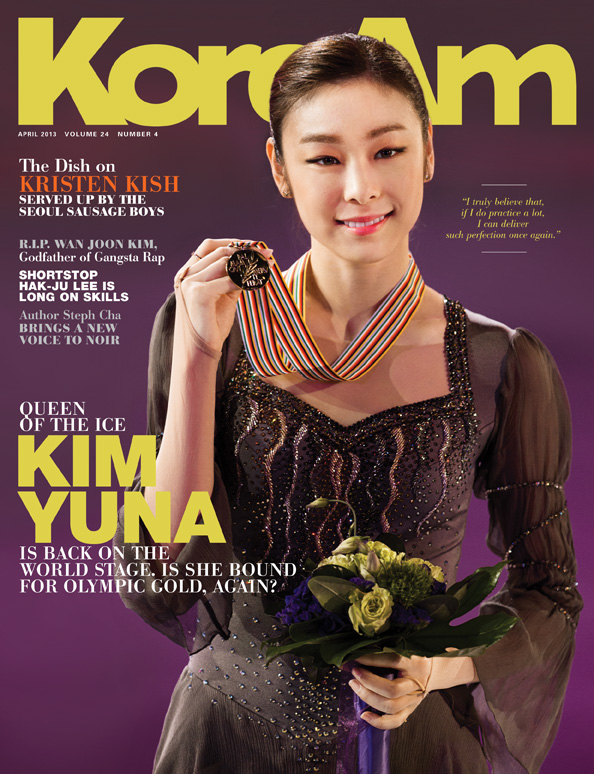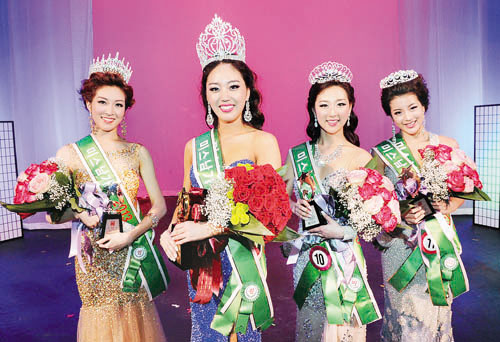The Queen is Back
Kim Yuna returns to the world stage, after 19 months away from competitive skating, and shows everyone—including herself—she just may be on the road to her second Olympic gold.
story and photographs by MARK EDWARD HARRIS
Some 500 sports journalists from around the world — I among them — descended upon London in Ontario, Canada, last month for the 2013 ISU World Figure Skating Championships. All of us were jostling for coverage of the most important skating event in the period leading up to the Olympics in Sochi, Russia, next year.
One of the main attractions, of course, was reigning Olympic champion Kim Yuna, the elegant South Korean skater who three years earlier had come to Canada, carrying the dreams of a nation excited by the prospect of Korea capturing its first Olympic gold medal in women’s figure skating. The pressure on the lithe skater’s shoulders, going into the 2010 Vancouver Olympic Games, was intense and palpable. But Kim would surpass her countrymen’s expectations by not only winning the gold, but also skatingperfect routines before a dazzled world audience.
Last month, Queen Yuna, as she is dubbed in Korea, was facing a different kind of pressure, however. The period after the Olympics had been rocky. She parted ways with her then-coach Brian Orser and skipped the entire 2011-12 season. After training in Los Angeles under American coach Peter Oppegard, she left him last year and returned to Korea to train with her childhood coaches, Shin Hye-sook and Ryu Jong-hyeon. Last July she announced that she wanted to return to competition and to skate in the 2014 Winter Olympics. But many speculated whether Kim’s competitive skating career was over; she had been away from this arena for 19 months, after all.
It was against this backdrop that Queen Yuna returned to the world stage last month, out to prove to her fans—and perhaps to herself—that there was still more for her to achieve.
Here is my journalist’s diary, in images and words, documenting Kim’s comeback journey at the worlds.
TUESDAY, MARCH 12
It’s practice day No. 2 in London, and Kim Yuna hits the ice both literally and figuratively. She has one fall, something that we’re not used to seeing, but she quickly picks herself up and continues with her practice. A day earlier, she had opted not to talk to the media, but after this evening’s practice, she consents to a short Q and A session with a small legion of journalists, including myself. Though she speaks conversational English, she feels more comfortable talking through an interpreter.
After answering questions about how she’s feeling coming into this competition and how’s she prepared for the smaller hockey rink in London, one reporter says, “You felt a lot of pressure before the events in 2009 and 2010. Do you feel the same pressure now or does having won the gold in Vancouver take a lot of the pressure off?” Kim explains that she doesn’t feel the same intensity as with the Vancouver Olympics. “However, because I am a human being, I want to do well,” she’s quick to add. “I want to deliver good results. In the press, I still hear comparisons between myself and [Japanese skatingcompetitor] Mao Asada. So the pressure is still there, but I try not to feel it as much.”
Another journalist asks what many in the public are wondering—if it’s difficult coming back after essentially reaching the pinnacle of her career and winning the Olympic gold.
“After I won the Olympics in Vancouver, like any other gold medalist out there, I did feel some emptiness in my heart,” Kim admits. “I thought about coming back to the ice for a long time. What motivated me to do it again is that skating is something that I’m best at and that I love the most, so I wanted to give it one more try.
“The 2010 Olympics was the first competition ever where I completed my short and free programs without any mistakes,” she continues. “They were clean programs. That, in itself, is a huge accomplishment. Delivering a clean program requires a lot of practice. I truly believe that, if I do practice a lot, I can deliver such perfection once again.”
WEDNESDAY, MARCH 13
The 2013 World Figure Skating Championships at the Budweiser Gardens kicks off today with the men’s singles. Kim does her practice sessions at the Western Fair ice rink, about a 15-minute drive from London. It gives her a chance to focus in relative solitude on tomorrow’s ladies short program, where 35 skaters are set to compete.
THURSDAY, MARCH 14 – LADIES SHORT PROGRAM
The alarm goes off at 6 a.m. I need to get to the arena and be ready to shoot Kim’s 7:55 to 8:25 a.m. practice session. She and five other skaters in this time slot will be on the ice for the duration, with each having their music played. Most of the skaters, including Kim, are in the outfits they’ll be wearing for the performance later today. After a successful practice session, Kim disappears into the bowels of the arena.
Some 6,000 skating fans now fill the seats of Budweiser Gardens. Two Zambonis make their way around the rink, while Kim and the other competitors in her flight prepare to take the ice. When 12:47 p.m. comes around, the crowd noise reduces to a hush as the Olympic gold medalist skates to the center of the ice. She will perform to the music “The Kiss of the Vampire,” by James Bernard, in a routine choreographed by Canadian David Wilson, who also choreographed her Olympic gold medal-winning routines. Kim opens with a triple lutz-triple toeloop, followed by a triple flip. A double axel, some highly technical footwork and a combination spin follow, delighting the appreciative crowd, which responds with cheers and applause.
After bows and curtsies, Kim makes her way to the kiss-and-cry couch to await her score. There will be no crying after this performance. Kim’s score of 69.97 points is announced, putting her on top of the leader board. There are 20 skaters who come after her, including some very formidable names in ladies figure skating. But Kim’s score holds up for the rest of the night. Italy’s Carolina Kostner, the defending world champion, comes in second with a 66.86, and Kanako Murakami of Japan finishes third with 66.64. A score of 65-plus is considered phenomenal. Mao Asada, hyped by the Korean media as Kim’s main rival, is in sixth place after a disappointing short program.
At a press conference later that day, Kim talks to reporters:
You did not seem pleased with your scores based on your reaction in the kiss-and-cry section?
When I heard my score I was a little surprised. My first thought was maybe my spin wasn’t good enough; maybe I got downgraded for that. However, on the TV screen, I checked, and it was OK. The first spin was a little unstable, but I really tried to hold onto it. In the end I know I tried my best, so I have no regrets.
How did you feel when you stepped on the ice?
I wasn’t as nervous as I had imagined I would be. I just kept trying to think that this was just another practice session and focused on that. In practices I was able to deliver my short programs without mistakes, so I felt confident being back on the ice. It’s been such a long time since I’ve competed in such a big venue with a lot of people filling the arena. But in the end, since I was doing well in the practices, I felt good.
Most skaters when they come back after competing in something as big as the Olympics find it really hard to prepare their physical and mental states. … Most skaters who come back do it right away, but it’s hard to get back on the ice with the same mentality that soon. However, I skipped a season after the win. It wasn’t an easy decision to make, but I made it, and now I’m just focusing on being back.
FRIDAY, MARCH 15
While the men take to the ice for their finals at Budweiser Gardens, Kim does two practice rounds at the Western Fair rink. Though she’s got the lead after the short program, nothing is guaranteed, and she knows it.
On her way out after practice, she responds to a question about how she’s feeling going into tomorrow’s final event. “I’ll try not to be too nervous about the long program,” she says. “I did a clean one at the Korean Nationals earlier this year, so I know I can do it.”
SATURDAY, MARCH 16 – LADIES FREE SKATE
The practice schedule today has Kim on the ice from 1 p.m. until 1:40 p.m. in a group with the top six finishers from the short program. Her music will be played last. After she finishes a flawless practice, she signs a few autographs. The next time she steps back on the ice, it will be in front of 6,000 fans in the arena and millions on television, who will know exactly what score she will need to solidify first place position. She is the final skater, No. 24 of 24.
At 9:58 p.m., it’s time for the final group to take the ice for a warm-up. Ashley Wagner of the United States, Kanako Murakami of Japan, Carolina Kostner of Italy, Mao Asada of Japan and Kaetlyn Osmond of Canada will skate before Kim.
Performing to “Bolero,” Kostner, the 2012 World champion, hits a triple lutz, triple flip-triple toe and two more triples, but falls on an under-rotated triple salchow. She also bravely struggles with a nosebleed that starts just before she begins and continues throughout the performance. She earns 131.03 points, bringing her accumulated total to 197.89. Asada meanwhile two-foots a triple-axel right out of the gate in her “Swan Lake” program, along with a few other minor errors, and her accumulated score is 196.47.
Kim’s name is announced, and she pensively takes the ice. The scoreboard shows that Kostner, currently in the lead, is the one to beat. Performing to “Les Miserables” (also choreographed by Wilson), she glides around the ice gaining momentum for a triple lutz-triple toe combination. She nails it. A magnificent triple flip, three more triple jumps, three level-four spins and level-four footwork follow. When she spins to a final stop at center ice, you sense she knows she has struck gold once again in Canada. She places her hand over her mouth as if she has surprised herself with another flawless performance, and the crowd is on its feet.
The Olympic champion scores 148.34 points in the free skate, bringing her overall total to 218.31 points, with the largest margin of victory in the nine worlds with the new scoring system. Kim earns her second world title and her fifth medal at the ISU World Championships. Kostner will get silver and Asada bronze.
At the post-event press conference, a beaming Kim admits that she was nervous in the six-minute free skate warm-up, but because she skated last, she was able to calm herself down. “I had a great long program today, and I am proud I could do it,” she says. “I am happy as well to skate here in Canada again with this wonderful audience.”
Indeed, Canada has certainly proven her good luck charm, offering her a stage where she could achieve perfection once again and show the world the queen is back.
Next stop: Sochi.
Special thanks to the Ontario Tourism Marketing Partnership Corporation, London Tourism, Skate Canada, and the International Skating Union for their assistance.
This article was published in the April 2013 issue of KoreAm. Subscribe today! To purchase a single issue copy of the April issue, click the “Buy Now” button below. (U.S. customers only. Expect delivery in 5-7 business days).











